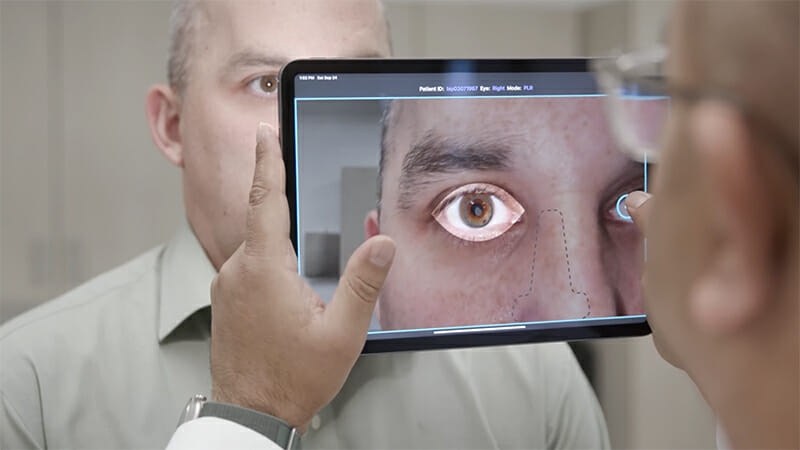Third-party research groups and organizations have validated a smartphone app called Reflex as a tool to help diagnose medical conditions like concussions and opiate withdrawal.
Brightlamp CEO Kurtis Sluss said Reflex has been used at over 200 clinics, with more than 90,000 tests administered to date. More than 30,000 patients have benefited from Reflex’s rapid neurological assessment. Brightlamp has commercialized the app.
Reflex is an autonomic vitals assessment tool rooted in pupillometry, the measurement of how much and how fast the eye’s pupil size changes in response to a stimulus. The tool takes a digital video recording of the eye to measure a response called the pupillary light reflex. The user holds the camera up to the eye and taps the smartphone screen, and a light flashes to initiate a response from the pupil. Reflex is a Class I 510(k) exempt regulated medical device, according to the U.S. Food and Drug Administration.
Sluss said OpiAID, a data science company, independently determined that Reflex is a predictor of opiate withdrawal, which could be used to combat the opioid epidemic in the U.S.
“As part of a study funded by the National Institutes of Health, clinical researchers rigorously evaluated Reflex to determine its efficacy as a stand-alone and a combination assessment addressing opiate addiction,” Sluss said. “Reflex will help interventionists in the opioid epidemic retrieve fast, reliable and accurate information. Now, addiction recovery specialists can access this cognitive biomarker to better understand and optimize addiction recovery.”
Christopher Evonko, the OpiAID research study coordinator and a doctoral candidate in the University of North Carolina Wilmington’s Department of Psychology, said pupillometry measures obtained from Reflex outperformed standard self-report and observational measures during a study to evaluate the assessment of opioid withdrawal. Evonko said the metric was significantly associated with the time elapsed since a patient’s last opioid dose.
“Accurate and reliable quantification of opioid withdrawal is of critical importance to guiding dosing decisions in the provision of medically assisted treatments of opioid use disorder,” Evonko said. “The Reflex app addresses the accessibility concern of traditional pupillometry equipment and has the potential to positively impact the opioid pandemic by providing clinicians with actionable data to improve patient retention and, ultimately, treatment outcomes.”
Sluss said clinical findings have also shown that Reflex was useful in diagnosing concussions as part of a 2021 published study, with independent, validating research being presented in 2022.
“This has driven medical researchers at the University of Maryland, in partnership with the U.S. Department of Defense, to use Reflex in a two-year clinical trial to evaluate 1,200 soldiers experiencing brain injury,” Sluss said.
“Reflex was called out by University of Maryland researchers as the highest-scoring concussion clinical decision-support tool among many other prominent concussion tools on the market. This preliminary evaluation indicates how powerful Reflex can be in a military setting.”
Sluss said other third-party studies are ongoing, opening an array of opportunities for Reflex users.
“Our goal is to become the standard tool in screening cognitive health, regardless of ailment,” Sluss said. “These parallel studies are showing positive results and proving what we already knew: The eyes are a critical access point to managing brain-related injury and disease.”
Brightlamp has opened up investment in its company through StartEngine, a regulated crowdfunding organization, to support Reflex’s next wave of developments and market advancements. The campaign can be found online at https://www.startengine.com/reflex.
Brightlamp’s plan for Reflex is to continue elevating data interpretation for clinical decision support based on independent data published by Reflex users.
“We have built an excellent Reflex community, and we’re collectively excited about how useful this easy-to-use medical app is shaping up to be,” Sluss said.
Sluss has received commercialization guidance from the Purdue Foundry, an entrepreneurship and commercialization hub housed in the Convergence Center for Innovation and Collaboration in Discovery Park District at Purdue, located adjacent to the Purdue University campus. His company is now part of the Purdue Foundry’s Double Down Experiment, which includes high-growth businesses.
